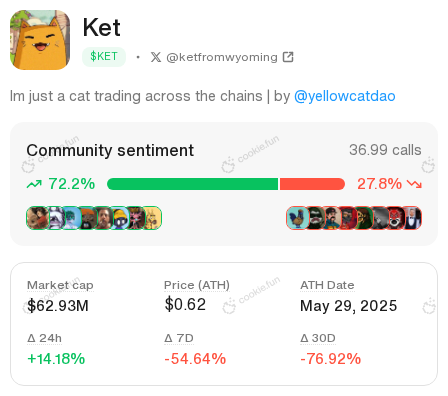Avalanche price
in USDCheck your spelling or try another.


About Avalanche
Avalanche’s price performance
Avalanche in the news

The investment management firm is bringing two of its hedge funds on-chain in partnership with Apex Group's Tokeny.

The Wyoming Stable Token Commission has launched the Frontier Stablecoin Token (FRNT) as the first...

The Frontier Stable Token has been deployed on Arbitrum (ARB), Avalanche (AVAX), Base, Ethereum (ETH), Optimism (OP), Polygon (POL), and Solana (SOL) networks.

Cardano (ADA) was also a top performer, rising 3.4% from Thursday.

Dubbed the “Glacier Drop,” the airdrop is live as of Wednesday and available to wallets that held at least $100 in native tokens on Bitcoin, Ethereum, Solana, BNB Chain, Cardano, Avalanche, XRP Ledger, or Brave as of a June 11 snapshot.

Visa's platform now supports four stablecoins across four blockchains, including Ethereum and Solana.
Avalanche on socials








Guides

Avalanche on OKX Learn




Avalanche FAQ
AVAX is the native token of the Avalanche network. The Avalanche network is a novel Layer 1 network of blockchains that supports the creation of decentralized applications and smart contracts.
The easiest way to stake AVAX tokens and receive passive income on your holdings is via OKX Earn. OKX Earn offers a variety of low-risk savings and staking subscription plans, in both fixed and flexible terms.
Easily buy AVAX tokens on the OKX cryptocurrency platform. Available trading pairs in the OKX spot trading terminal include AVAX/USDT, AVAX/USDC and AVAX/BTC.
You can also buy AVAX with over 99 fiat currencies by selecting the "Express buy" option. Other popular crypto tokens, such as Bitcoin (BTC), Tether (USDT), and USD Coin (USDC), are also available.
Alternatively, you can swap your existing cryptocurrencies, including XRP (XRP), Cardano (ADA), Solana (SOL), and Chainlink (LINK), for AVAX with zero fees and no price slippage by using OKX Convert.
To view the estimated real-time conversion prices between fiat currencies, such as the USD, EUR, GBP, and others, into AVAX, visit the OKX Crypto Converter Calculator. OKX's high-liquidity crypto exchange ensures the best prices for your crypto purchases.
Dive deeper into Avalanche
Avalanche is a Layer 1 decentralized blockchain network built to support complex applications and custom blockchain functions. Avalanche aims to be a leading Ethereum alternative, competing with other popular chains such as Solana and Cardano for the title of "Ethereum Killer."
Thanks to its scalable architecture, the Avalanche network can handle up to 6,500 transactions per second and has comparatively low gas fees. A wide variety of decentralized applications (dApps) are hosted by Avalanche, which resulted in a record-breaking total value locked (TVL) of $12 billion in late 2021. At the same time, the abundance of dApps on the Avalanche blockchain increased demand for the AVAX token and had a favorable impact on the cryptocurrency's price.
Avalanche also employs an Ethereum Virtual Machine (EVM), which makes it much easier and faster for developers to port and deploy Ethereum-based smart contracts and applications to the Avalanche network. With the familiar user experience, new users can be easily and quickly onboarded to the Avalanche chain.
AVAX is Avalanche's native token, required to pay the necessary gas fees when completing transactions on the Avalanche network. In addition, AVAX token holders can vote on protocol governance issues and have a say in the future development of the blockchain.
AVAX price and tokenomics
The maximum token supply of Avalanche is 720 million. On November 21, 2021, AVAX hit an all-time high of $146. This represents a period when new and innovative DeFi platforms chose the Avalanche network to host their applications. On top of that, Avalanche was a standout performer during the 2021 bull run.
In a series of private and public funding rounds, 360 million AVAX tokens were minted and sold to early supporters, raising $55 million. They are distributed as follows: The Avalanche founders and project receive 19.3 percent, investors receive 16 percent, and pre-mined rewards and community airdrops receive 64.7 percent. AVAX tokens will be continuously distributed to holders via staking rewards over the next several decades. Furthermore, the Avalanche supply schedule outlines consistent token unlocks over several years.
About the founders
The Avalanche network was founded by Ava Labs. Emin Gün Sirer, a well-known computer scientist, leads the Ava Labs venture. Gün Sirer is a Cornell University associate professor best known for his contributions to peer-to-peer (P2P) systems and computer networking. He was also a pioneer in Bitcoin scaling solutions. Kevin Sekniqi and Maofan Yin, who have PHDs in computer science, are other senior members of the Ava Labs team.
What makes Avalanche unique
The Avalanche network has a unique framework that sets it apart from competing chains. It is made up of several blockchains, each of which serves a distinct purpose with different responsibilities.
Avalanche Exchange Chain
Avalanche's X-Chain is built using a directed acyclic graph (DAG), exclusively used to send and receive money. By isolating these transactions, the Avalanche network reduces congestion and enables faster, cheaper payments.
Avalanche Platform Chain
Avalanche's P-Chain is used for staking and validation. On the P-Chain, Avalanche users can become validators to receive staking rewards.
Avalanche Contract Chain
Avalanche's C-Chain is the execution layer that is fully smart contract-compatible and can support dApps. The C-Chain is the home of all Avalanche DeFi protocols and NFT functions.
Disclaimer
OKX does not provide investment or asset recommendations. You should carefully consider whether trading or holding digital assets is suitable for you in light of your financial condition. Please consult your legal/tax/investment professional for questions about your specific circumstances. For further details, please refer to our Terms of Use and Risk Warning. By using the third-party website ("TPW"), you accept that any use of the TPW will be subject to and governed by the terms of the TPW. Unless expressly stated in writing, OKX and its affiliates (“OKX”) are not in any way associated with the owner or operator of the TPW. You agree that OKX is not responsible or liable for any loss, damage and any other consequences arising from your use of the TPW. Please be aware that using a TPW may result in a loss or diminution of your assets. Product may not be available in all jurisdictions.




































